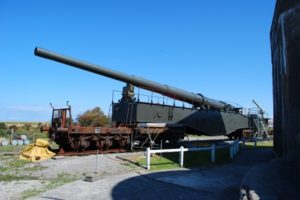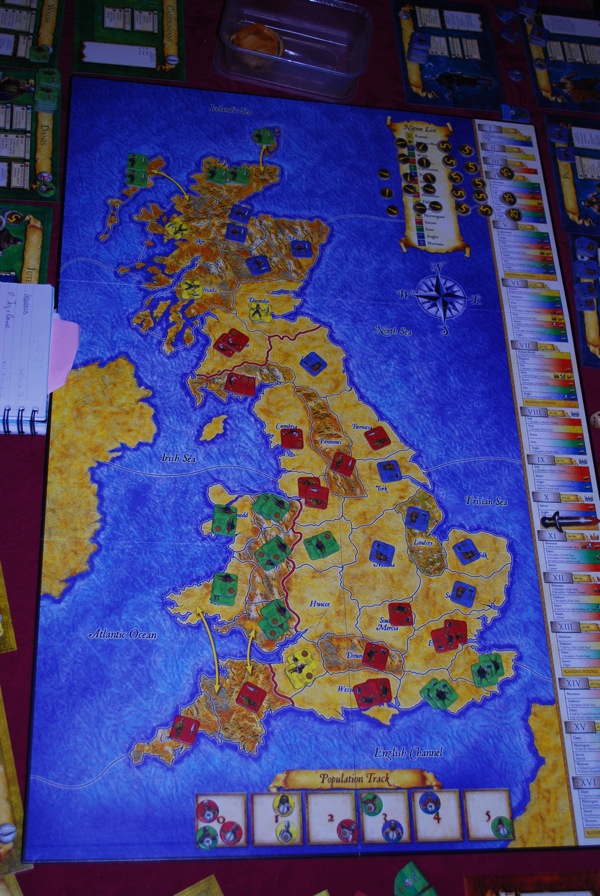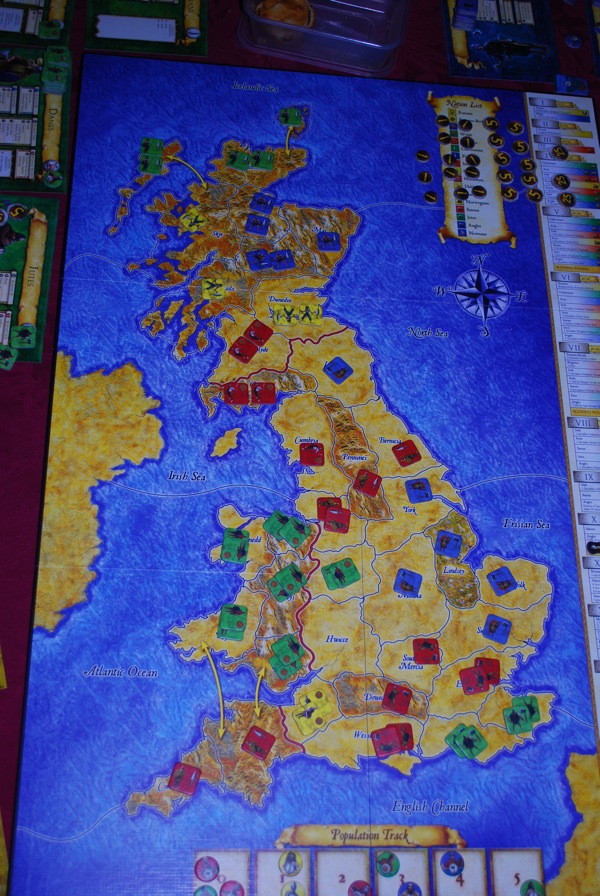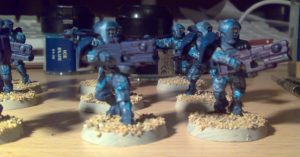24 hastati are now painted and are gluing to their bases. The shields for the Italian ones are done but not the Roman ones as I am waiting for some transfers. Must buy some superglue tomorrow for the swords. I have now retired to the pub to celebrate being ahead of schedule.
Zama Part 2 – the terrain
I’m not doing the terrain (hurrah) but I am providing the Roman army, so it would be good if my bases vaguely matched the terrain. In aid of that, here are 3 very large pictures of some sample hastati and principes. The colour is as balanced as I can make it – it was taken with a flash – and the cloth is a Games Workshop green cloth for reference.
The figures are all Gripping Beast, and very nice they are too. The painting is all mine, and it shows :). Except that is for the shields; they are transfers from Little Big Men.
Click on the photos for a full size version.
The Calais Railway Gun

A picture from the summer here, that I found when looking for something else in my photo archive. Its the WW2 German K5 railway gun at a museum on Cap Gris Nez near Calais. I dragged the family there when we were early for our ferry.
The K5 is seriously impressive just for its sheer scale – the guns at the entrance of the Imperial War Museum are on a similar scale but aren’t mounted, so lack the impact.
For those who want technical details, its a 283mm calibre gun (~11″) that fired shells weighting 255 kg up to 50 kilometres.
Planning for Zama (Part 1)
David Mather and I at the Pinner Wargames Club have agreed to provide the armies for the DBMM refight of Zama at the upcoming Society of Ancients Battle Day in April, so now is the time to start thinking about how many figures we are going to need for that.
I am providing the Roman army, and the main sources for the battle are Polybius, Livy and Plutarch (mainly the first two). Livy seems to mainly cover it in books 28 and 29. In book 28 Publius Cornelius Scipio is sent to Sicily with 7,000 volunteers. Here he has two legions (V and VI) which seem to be the disgraced remnants of the survivors of Cannae, back in 216 BC, over a decade earlier. In book 29:24 he is described as bringing each legion up to a strength of 6,200 infantry and 300 cavalry, and also bringing their socii contingents up to strength as well (presumably the same strength but with more cavalry as usual). He then in section 25 comes up with 3 different values for the size of the army, none of which match this (there are either 10,000, 16,000 or 32,000 infantry – 4 x 6,200 is 24,800).
Now if we look at Polybius’ account of the structure of the legion, he says that it should contain 4,200 infantry (or 5,000 at times of emergency) (III:20). Add to this the same number of socii, and then double it for two legions and you would get 16,800, or 20,000). On the other hand, these aren’t normal legions, so they probably weren’t formed using the text-book system.
He then tells us that there are 600 triarii, 1,200 principes, 1,200 hastati and the rest are velites (by subtraction another 1,200). He also says that the ratios remain the same if the size increases, except that there are still always only 600 triarii.
The two most important classes are the hastati and the principes, both by now identically armed but the principes being men in the prime of life (the hastati being younger). Each legion should contain 10 maniples of principes and 10 of hastati, each with 2 centurions (and therefore by implication 2 centuries although he doesn’t use that word). Polybius also says in his description of the layout of the camp that there are only half the number of triarii (the oldest men) as there are principes or hastati (he at least is consistent).
Thus each maniple should be 120 men, making them much smaller than the maniples in Caesar’s time. If we take Livy’s numbers of 6,200 per legion, and assume that there are still only 600 triarii, that leaves 5,600 for the other ranks, which is inconveniently indivisible by 3. Lets therefore err downwards and assume 1,800 each of principes, hastati and velites, giving us 6,000 men per legion. That would then give us maniples of 180 men, now actually slightly larger than in Caesar’s time.
How does this all fit into DBMM?
Well the standard figure scale is 200 – 250 men per element. We’re going to double this (because we can’t afford that many figures). So lets assume 400 men per element. This would give us 1.5 elements of triarii, 4.5 of principes, 4.5 of hastati and 4.5 of velites per legion. I don’t like this because I want to have shield patterns per legion, so lets play fast and loose with the element scale (since the original numbers are pretty dodgy). This could then give us 2 elements of Sp(S) triarii, 4 elements of Bd(O) hastati, 4 elements of Bd(O) principes and 4 elements of Ps(S) velites per legion, which is a pleasing ratio of elements. It also doesn’t do too much damage to the original sources being somewhere in the middle of the mess.
Next – ground scale and how that fits in.
Update on panzergrenadiers
Snow
Britannia interruptus
A great game of Britannia with David, Peter and Iain last night (or rather the first half of a great game – we didn’t get time to finish). Anyway – here are the photos I took of the board so that we can set it back up again to finish the game some time:

And again:

I’m yellow – yes that’s the one with only 4 territories. I had a bit of a mare with the Romans but hopefully I got enough points to keep me in the running if I do OK with the Norwegians and the Dubliners.
Green (David) is currently in the lead due to a very strong performance from the Welsh, helped by the Saxons having had a bit of a hard time from the Romans when they first arrived.
Lost Battles
An exciting and ultimately close battle using Phil Sabin’s Lost Battles rules last night against Darth Mather. We were refighting 2nd Coronea – he was Agesilaus, I was the humdrum allied hoi polloi. I felt I was doing very well initially as I pushed forward my right flank and broke right through his weak left flank and was getting the better of the melee in the centre, while his right flank commanded by Agesilaus was just sitting there like a bunny in the headlights, but two poor morale rolls saw me loosing all my remaining hoplites on my right flank and in the centre as they were already spent. I used my last command points to withdraw my hoplites on the left unengaged and end the battle. When we added up the points though, the 26 point bonus for starting the battle with only 51 points to the Spartan 64 points, and that most of my hoplites had fled because of poor morale rather than being shattered in close combat meant that Mather had actually only won by 70 points to 67, which was pretty close.
All in all a very enjoyable battle. In the last turns I felt like I was being rolled over, but since that was pretty much what happened in real life I felt that the scoring system worked wonders in showing that really I did no better or worse than could be expected with the forces at my disposal. A refreshing change from the equal points fantasy historical match-ups that I am more used to.
No pictures unfortunately, which is probably a good thing.
Speed painting
An interesting Thursday evening. I had planned a gentle potter in the study, possibly aiming to clear the tray of half assembled figures on the tray on top of the printer so that I can actually print stuff out again. Instead a friend of mine IMed me in the afternoon looking for some Tau fire-warriors with pulse carbines to use in a competition at the weekend. Never wishing to let a friend down, and since I did vaguely remember having some undercoated sprues of the aforementioned warriors in the garage, I leapt into action once I got home (via a brief interlude unblocking my parents-in-law’s sink).
A brief expedition into the further recesses of the garage located the sprues in question. A rapid tally of the parts revealed that I could only make 9 warriors with pulse carbines from the sprue, and even then only if 3 of them were actually lobbing grenades and just holding carbines in the other hand (which is a slightly strange posture since the pulse carbine has an underslung grenade launcher begging the question of why you would throw a grenade when you have a machine that preseumably can do it for you much better).
Anyway, I quickly assembled these and undercoated them with Shadow Grey. I painted the various bits of hardware (carbines, backpacks) with Midnight Blue and drybrushed them lightly with Shadow Grey. The bodies I then quickly painted with splinter camouflage in Space Wolves Grey, Ice Blue and Fortress Grey and then gave the whole thing a quick blue ink wash.
Here is a very poor photo of them – I would take a better one but they have already gone off to battle. I suspect a better picture will just show up the deficiencies of the paint job though. Originally I was going to do Tau in a red/brown colour scheme – these are blue/grey to fit in my David’s army better, but I actually think I prefer the blue/grey colour scheme.

Ottomans
I’ve just realised that there are no pictures of my Ottomans up here, only over on the Pinner Wargames website. So here they are, the result of some focused evening painting while on holiday in Wales. Apologies as usual for the quality of the photos. I must find my tripod so I can take some photos where the depth of field is more than about 3 mil. I seem to remember seeing it somewhere in the garage about 6 months ago when I was looking for something else, although I can’t remember if I ignored it or hoiked it out on the grounds that it didn’t belong in the garage.
First up are the sipahis – the feudal landowner cavalry, normally armoured and armed with bows and a mix of lances and hand weapons. I’m experimenting with a fairly fast painting style at the moment with a base colour, some quick high-lighting and then a wash, in this case Devlan Mud from GW.

The other figures that I almost finished are the akinjis. I say almost finished because I am 4 riders short, which is irritating. I am hoping that when I split the packs with Lord Mather we just miscounted and I can scrounge the missing 4 figures off him. Akinjis are the rabble peasant light cavalry, unarmoured and bow armed and fighting for loot rather than duty.

I also managed to paint some voynuks, but there are no pictures as yet because I have run out of grass for their bases. Plus I can’t actually fit them into the army. Ho hum, I am sure they will come in handy in other eastern European mediaeval armies.
Still to come are the generals and the kapikullu – I have some figures but I need to replace the lances and I am looking for some more inspiring general figures.
The janissaries are done as well, they just need to be photographed.
Last is the azabs – I don’t even have the figures for them yet.




